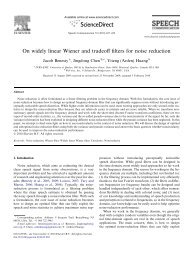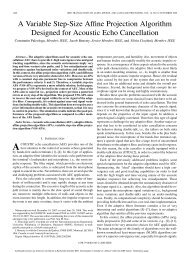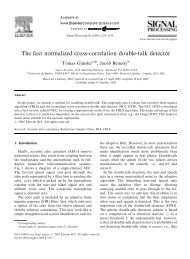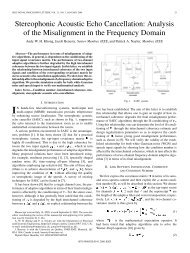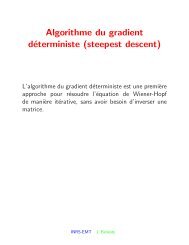A Generalized MVDR Spectrum - ResearchGate
A Generalized MVDR Spectrum - ResearchGate
A Generalized MVDR Spectrum - ResearchGate
You also want an ePaper? Increase the reach of your titles
YUMPU automatically turns print PDFs into web optimized ePapers that Google loves.
828 IEEE SIGNAL PROCESSING LETTERS, VOL. 12, NO. 12, DECEMBER 2005<br />
Therefore, plugging (5) into (6), we find that<br />
(7)<br />
The first obvious choice for the unitary matrix<br />
Fourier matrix<br />
is the<br />
Expression (7) is a general definition of the spectrum of the<br />
signal , which depends on the unitary matrix . Replacing<br />
the previous equation in (5), we get<br />
where<br />
Taking into account all vectors<br />
the general form<br />
where<br />
(8)<br />
, (8) has<br />
(9)<br />
and . Of course, is a<br />
unitary matrix. With this choice, we obtain the classical Capon’s<br />
method.<br />
Now suppose . In this case, a Toeplitz matrix is<br />
asymptotically equivalent to a circulant matrix if its elements<br />
are absolutely summable [8], which is usually the case in most<br />
applications. Hence, we can decompose as<br />
(12)<br />
and<br />
diag<br />
is a diagonal matrix.<br />
Property 1: We have<br />
(10)<br />
Proof: This form follows immediately from (9).<br />
Property 1 shows that there are an infinite number of ways<br />
to decompose matrix , depending on how we choose the<br />
unitary matrix . Each one of these decompositions gives a<br />
representation of the square of the spectrum of the signal<br />
in the subspace .<br />
Property 2: We have<br />
Proof: Indeed<br />
tr<br />
tr tr (11)<br />
tr<br />
Property 2 expresses the energy conservation. So no matter<br />
what we take for the unitary matrix , the sum of all values of<br />
the inverse spectrum is always the same.<br />
A. Particular Cases<br />
In this subsection, we propose to briefly discuss three important<br />
particular cases of the general form of the <strong>MVDR</strong> spectrum.<br />
tr<br />
tr<br />
so that . As a result, for a stationary signal and asymptotically,<br />
Capon’s approach is equivalent to the periodogram. The<br />
difference between the <strong>MVDR</strong> and periodogram approaches can<br />
also be viewed as the difference between the eigenvalue decompositions<br />
of circulant and Toeplitz matrices. While for a circulant<br />
matrix, its corresponding unitary matrix is data independent,<br />
it is not for a Toeplitz matrix.<br />
The second natural choice for is the matrix containing the<br />
eigenvectors of the correlation matrix . Indeed, it is well<br />
known that can be diagonalized as follows [9]:<br />
(13)<br />
where is a unitary matrix containing the eigenvectors , and<br />
is a diagonal matrix containing the corresponding eigenvalues<br />
. Thus, taking ,wefind that and<br />
(14)<br />
In many applications, the process signal is real, and it<br />
may be more convenient to select an orthogonal matrix instead<br />
of a unitary one. So our third and final particular case is the<br />
discrete cosine transform<br />
where the rest is shown in the equation at the bottom of the<br />
page, with and for .We<br />
can verify that<br />
. So with this orthogonal<br />
transform, the spectrum is<br />
diag (15)



